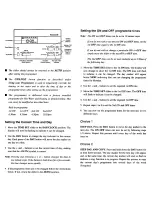
20
19
Slimline
Series
Model
: PRT / PRT-N
Optional Features Explained
THE FOLLOWING SETTINGS ARE OPTIONAL AND IN MOST CASES
NEED NOT BE ADJUSTED
Feature 01 - Temperature Format:
This function allows you to select between °C and °F.
Feature 02 – Switching Differential:
This function allows you to increase the switching
differential of the thermostat. The default is 1°C which means that with a set temperature
of 20°C, the thermostat will switch the heating on at 19°C and off at 20°C.
With a 2°C differential, the heating will switch on at 18°C and off at 20°C.
Feature 03 – Frost Protect:
You can set whether the thermostat will maintain the frost
temperature when the thermostat display is turned off. As a default, this is enabled.
Feature 04 – Frost Protect Temperature:
This is the temperature maintained when the
thermostat is in frost mode. The range is 07 - 17°C. The default is 12°C and is suitable for
most applications.
Feature 05 – Output Delay:
To prevent rapid switching, an output delay can be entered.
This can be set from 00 - 15 minutes. The default is 00 which means there is no delay.
Feature 06 – Communication Address:
This setting is used when you have connected
your thermostat to a network system. Each thermostat on your network must have a
unique communication address. This can be set from 01-32.
Feature 07 – Temperature Up/Down Limit:
This function allows you to limit the use
of the Up and Down keys. This limit is also applicable when the thermostat is locked
and so allows you to give others limited control over the heating system.
Feature 08 – Sensor Selection:
This thermostat has a built in air sensor.
Feature 09 – Floor Temp Limit:
This function is not available on this model.
Feature 10 – Optimum Start:
Optimum start will delay the start up of the heating
system to the latest possible moment to avoid unnecessary heating and ensure
the building is warm at the programmed time. The thermostat uses the rate of
change information to calculate how long the heating needs to raise the building
temperature 1°C (with a rate of change of 20, the thermostat has calculated the
heating needs 20 minutes to raise the building temperature 1°C) and starts the
heating accordingly.
Feature 11 – Rate Of Change:
This is the number of minutes the thermostat has
calculated it takes to raise your building temperature 1°C. The thermostat will
continue to monitor and learn the heat up time of your home to optimise heating
efficiency.
Feature 12 - Programming Mode:
The thermostat offers 2 programming methods.
Weekday/Weekend allows you to program 4 comfort levels for the weekdays and
4 different comfort levels for the weekend. In 7 Day program mode, each day has 4
comfort levels that can be programmed independently.
Содержание PRT
Страница 1: ...1 Model PRT PRT N Model PRT PRT N...



































